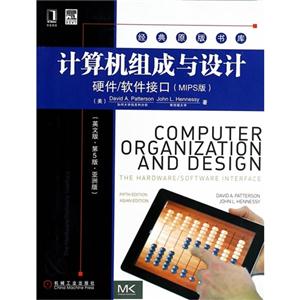-
>
全国计算机等级考试最新真考题库模拟考场及详解·二级MSOffice高级应用
-
>
决战行测5000题(言语理解与表达)
-
>
软件性能测试.分析与调优实践之路
-
>
第一行代码Android
-
>
JAVA持续交付
-
>
EXCEL最强教科书(完全版)(全彩印刷)
-
>
深度学习
倾城-中国历史上的30位女性
¥14.6¥40.0计算机网络:自顶向下方法(英文版·原书第7版)
¥185.6¥269.0楚辞-(全二册)
¥97.0¥198.0我就是我张国荣的音乐人生
¥13.7¥39.8宋美龄年谱(精装)
¥36.3¥98.0
计算机组成与设计-硬件/软件接口-(第5版)-(MIPS版)-(英文版.亚洲版) 版权信息
- ISBN:9787111453161
- 条形码:9787111453161 ; 978-7-111-45316-1
- 装帧:一般胶版纸
- 册数:暂无
- 重量:暂无
- 所属分类:>
计算机组成与设计-硬件/软件接口-(第5版)-(MIPS版)-(英文版.亚洲版) 本书特色
帕特森、亨尼斯所著的《计算机组成与设计(硬件软件接口MIPS版英文版第5版亚洲版)》包含新的实例、练习和资料,重点介绍新出现的移动计算和云计算。涵盖从串行计算到并行计算的革命性变革,特别用一章篇幅讲述并行处理器,并且每章中还有一些强调并行硬件和软件主题的小节。全书采用Intel Core i7、ARM Correx-A8和NVIDIA Fermi GPU作为实例。增加一个新的实例“Going Faster”,展示正确理解硬件技术能够激发软件优化,提高200倍的性能。 讨论并强调计算机体系结构的“八大理念”——Performance via Parallelism;Performance via Pipelirring;Performa rice via Prediction;Design for Moore's Law;Hierarchy of Memories;Absttraction to Simplify Design;Make the Common Case Fast;Dependability via Redundancy。 全面更新和改进了练习。
计算机组成与设计-硬件/软件接口-(第5版)-(MIPS版)-(英文版.亚洲版) 内容简介
帕特森、亨尼斯所著的《计算机组成与设计(硬件软件接口MIPS版英文版第5版亚洲版)》这本*畅销的计算机组成与设计的经典教材经过全面修订,关注后PCB寸代发生在计算机体系结构领域的革命性变革(从单处理器发展到多核微处理器。从串行发展到并行),并强调了新出现的移动计算和云计算。为了研讨和强调这种重大的变化,《计算机组成与设计(硬件软件接口MIPS版英文版第5版亚洲版)》更新了许多内容,重点介绍平板电脑、云体系结构以及ARM(移动计算设备)和x86(云计算)体系结构。因为正确理解现代硬件对于实现好的性能和能效至关重要,所以本版在全书中增加了一个新的实例“GoingFaster”,以演示非常有效的优化技术。本版还新增了一个关于计算机体系结构“八大理念”的讨论。与前几版一样,本书采用MIPS处理器来展示计算机硬件技术、汇编语言、计算机算术、流水线、存储器层次结构以及I/O等基本功能。
计算机组成与设计-硬件/软件接口-(第5版)-(MIPS版)-(英文版.亚洲版) 目录
- >
二体千字文
二体千字文
¥14.0¥40.0 - >
朝闻道
朝闻道
¥14.8¥23.8 - >
人文阅读与收藏·良友文学丛书:一天的工作
人文阅读与收藏·良友文学丛书:一天的工作
¥15.7¥45.8 - >
山海经
山海经
¥18.7¥68.0 - >
随园食单
随园食单
¥16.4¥48.0 - >
月亮虎
月亮虎
¥15.4¥48.0 - >
企鹅口袋书系列·伟大的思想20:论自然选择(英汉双语)
企鹅口袋书系列·伟大的思想20:论自然选择(英汉双语)
¥6.3¥14.0 - >
莉莉和章鱼
莉莉和章鱼
¥14.4¥42.0
-
大模型应用开发极简入门 基于GPT-4和ChatGPT
¥41.9¥59.8 -
人工智能 现代方法 第4版(全2册)
¥120.8¥198 -
计算机视觉:算法与应用
¥95.9¥139 -
必然(修订版)
¥53.5¥89 -
GPT时代人类再腾飞
¥54.9¥89.9 -
生成式人工智能(AIGC)应用
¥64.9¥90
生物统计学
¥24.1¥42.0跨流域调水工程突发水污染事件应急调控决策体系与应用
¥38.0¥48.0松软煤层抽采钻孔变形失稳特性及其影响机制
¥32.5¥42.0多媒体技术与信息化教学设计基础
¥18.2¥35.1开放条件下的中国经济内外均衡研究
¥9.3¥19.0


















